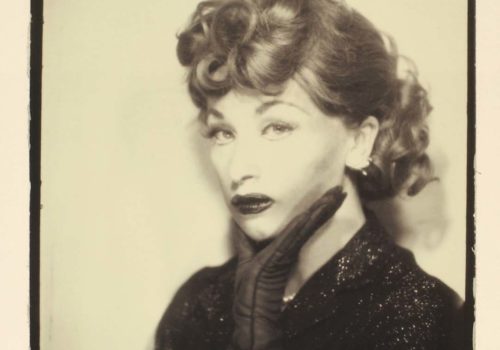Chaka Khan most famously sang, “I am every woman” and no artist embodies this quite as brilliantly as Cindy Sherman. She has been remaking herself in the image of others throughout her career, giving a spellbinding performance of gender roles assigned to (mostly) Caucasian women as they are created and lived by countless females. Her ability to transform reveal the plasticity of identity as it is defined by appearance and affect, by the way in which we unconsciously communicate our fears and dreams through non-verbal cues.
The photograph is the ideal medium for Sherman’s experiments and discoveries, the still image being a soundless, wordless, motionless space for eternal contemplation. Sherman’s uncanny ability to play a role, to construct an entire narrative into a single frame is nothing short of remarkable. What is perhaps shocking is that she has been doing this for close to forty years, and her earliest work is just as profound and compelling as that of her later years.
These works are collected together for the first time in Cindy Sherman: The Early Works 1975–1977 Catalogue Raisonné (Hatje Cantz). This volume is simply magnificent, a breathtaking tour-de-force that unfolds with image after image of the artist who would come to embody an iconography all her own, a kind of storytelling that has no precedent on this scale in the medium.
What makes The Early Works compelling is the simplicity of the work and the way in which this is mirrored in the production of the book. It is understood this book will be grand from the very opening of the front cover, as a bright orange matte jacket flap rest against silver endpapers,the book is 376 pages. It is substantial, and statuesque as gatefold after gatefold reveal themselves. The works inside are pure pleasure, presented against a vast expanse of white space. They sit there, one after another, variations on a theme, repetitions to derive an effect, a kind of very clever inside joke with yourself. Sherman’s ease into the odd characters she creates are clearly a kind of genius that is perfectly suited to the medium of photography. The pleasure of this book is seeing her brilliance in its earliest stage, and the way in which she was always born to stand before a camera in order to create the image in her mind.
As Sherman notes in the beginning of Gabriele Schor’s essay, “Even though I’ve never actively thought of my work as feminist or as a political statement, certainly everything was drawn from my observations as a woman in this culture. And a part of that is a love/hate thing—being infatuated with makeup and glamour and detesting it at the same time. It comes from trying to look like a proper young lady or look as sexy or as beautiful as you can make yourself, and also feeling like a prisoner of that structure.”
Indeed, that structure forms the basis of her iconography, and the sense of imprisonment is palpable in some of her more emotionally tense scenes, Her explorations extend far beyond the frame of femininity, giving us a sense of a certain femaleness that every woman is confronted with as she reaches maturity. The Early Works offers a larger context in which to place this new frame, particularly with the facsimile of Script Notes for “A Play of Selves” written in 1976.
Here Sherman puts into words what she has been saying with imagery, a cast of characters that include A Broken Woman, The Vanity, The Madness, The Agony, The Desire, The Actual Main Character, and The Character As Others See Her, among others. We are then given four acts and a finale, each outlined with scenes, and with these pages we are given a concrete look at the structure of Sherman’s mind during the process of creation as she maps idea into actuality. Following the acts, we are given two pages that tell us about the order of characters photographed, which are then illustrated in the actual works themselves.
For this project, Sherman cut out full-body portraits so that they appear as paper dolls, each posed in specific stances to communicate meaning through gesture, emotion, and juxtaposition with one another. The facsimile pages let us know exactly what we are looking at, creating a sense of silent film as the pages unfold. And it is just this silence that makes the photograph so profound, the way in which we are invited to fill in the blanks by creating meaning through the implications of Sherman’s work.
The Early Works is a deeply fulfilling experience, not only because of its dedication to detailing this period of the artist’s work, but also because of Sherman herself. Her clarity of vision and the proliferation of her ideas present Sherman as something of an Athena, springing fully armed from the mind of Zeus himself. There is something of the warrior in Sherman’s work throughout her career, a tireless champion whose commitment to the medium has forever transformed our ideas about photography, the female gaze, and the construction of identity itself.
Miss Rosen
















